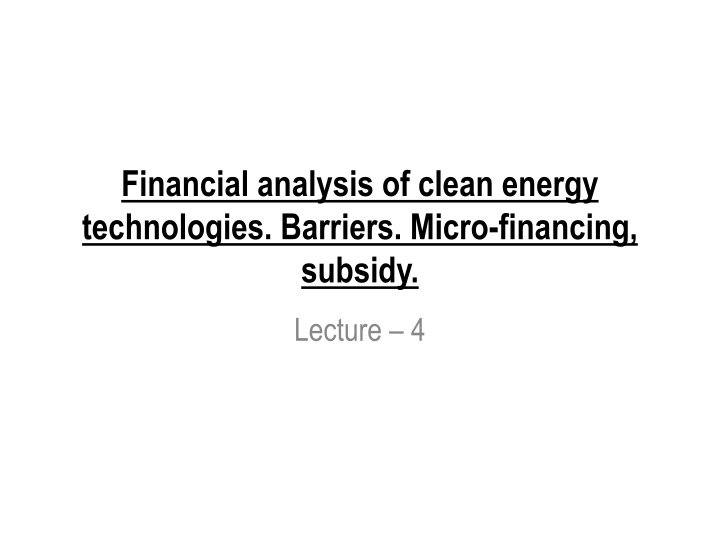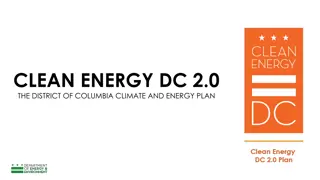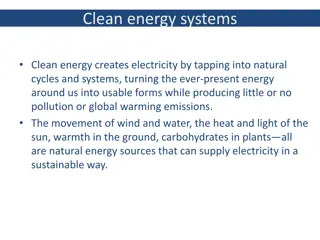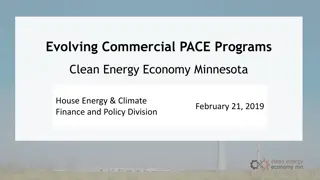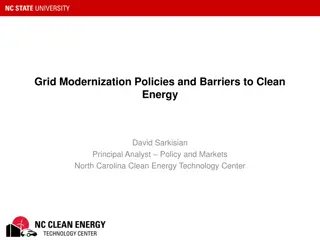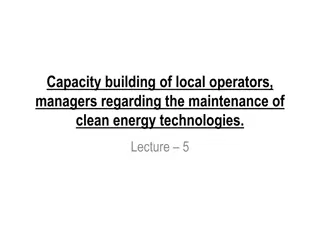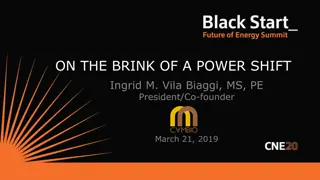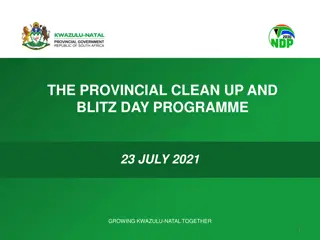Financial Analysis and Management of Clean Energy Technologies
Delve into the world of clean energy technologies with a focus on financial analysis, micro-financing, and overcoming barriers in implementing sustainable solutions. Explore project management strategies, basic financial terms, and examples illustrating the evaluation of clean energy projects through concepts like Net Present Value and required growth rates.
Download Presentation

Please find below an Image/Link to download the presentation.
The content on the website is provided AS IS for your information and personal use only. It may not be sold, licensed, or shared on other websites without obtaining consent from the author.If you encounter any issues during the download, it is possible that the publisher has removed the file from their server.
You are allowed to download the files provided on this website for personal or commercial use, subject to the condition that they are used lawfully. All files are the property of their respective owners.
The content on the website is provided AS IS for your information and personal use only. It may not be sold, licensed, or shared on other websites without obtaining consent from the author.
E N D
Presentation Transcript
Financial analysis of clean energy technologies. Barriers. Micro-financing, subsidy. Lecture 4
OUTLINE OF COURSE MANAGEMENT OF MICRO LEVEL CLEAN ENERGY PROJECTS Introduction to project management for clean energy system at micro level. Functions of project based management: scope of work, project organization, quality, cost and duration Tools and techniques of project-based management Project life cycle. Processes of project management. Types of management Methods of selecting sustainable clean energy technologies for the household, community. Social, economical and technical impact of selected clean energy technologies Financial analysis of clean energy technologies. Barriers. Micro- financing, subsidy. Capacity building of local operators, managers regarding the maintenance of clean energy technologies. Project management of micro level clean energy projects (such as MHP, SHS, wind energy for electricity generation and irrigation, biomass gasifiers etc.). 2
Basic terms Net Present Value (NPV) Present Value Future Value Discount Rate Internal Rate of Return (IRR) Sensitivity Analysis 3
Financial analysis Time value of money Principle Interest: simple, compound FV = PV 1 ( + n ) r Cash flows Net cash flow =Revenue or saving production cost taxes- capital The time value of money looks at the timing of investments and income; money received sooner is more important than equal money received in the future. The cash flow is a series of negative and positive values reflecting how money flows from and to an investor. Investors must look at incremental cash flows. 4
Example 1 The estimated salvage value of a flat plate solar collector at the end of its useful lifetime of 20 years is Rs 5,000 determine it present worth for a discount rate of 10 percent. FV = PV 1 ( + n ) r PV = 5,000/(1+ 0.1)^20 =Rs 743.22 5
Example 2 It is estimated that about 4.5 million households in the country can benefit fro the use of improved biomass cook stoves. What is the required growth rate to achieve the potential in the next 20 years if the number of improved biomass cook stoves disseminated so far is 0.3 million? [Ans. r=14.5%] A 2 m3 biogas plant cost Rs. 10,000 and has a useful life of 20 years. Calculate the unit cost (Rs/m3) of biogas produced if the annual average biogas production efficiency is 90%, average maintenance cost is 5%of the capital cost and the discount rate is 12%.] [Ans. Rs 2.80/m3. Hint: Annualized capital cost = Principal*[r*(1+r)^n/((1+r)^n-1)] 6
Financial tools: NPV, IRR Net present value The net present value is the revenue or savings derived from an investment, less its cost. Future values are brought back to the present at a compound interest rate called the discount rate. This discount rate (discount factor) is also called the Cost of capital Opportunity cost of capital Hurdle rate Minimum rate of return Minimum acceptable rate of return Discounted cash flow = cash flow x discount factor NPV = sum of discounted cash flow = cum discounted cash flow at the end of project 1 = Discount rate + n 1 ( r) 7
Net present value where: Ct= the net cash receipt at the end of year t Io= the initial investment outlay r = the discount rate/the required minimum rate of return on investment n = the project/investment's duration in years. Decision: If NPV is positive (+): accept the project If NPV is negative(-): reject the project 8
Example 3-A A small windmill for water pumping costs Rs 10,000 to purchase and install on the field of a farmer. It is expected to save Rs 800 worth of diesel annually to the farmer and its annual maintenance cost is estimated at Rs 200. calculate the NPV of the investment on the windmill if the useful life of the windmill is 10 years and the interest rate is 12%. ( i 1 ( ) N + N 1 1 i (For even cash flow) + = C B I NPV ) ( 0 + ) i ( ) 10 + 1 . 0 12 1 = + 10 , 000 800 ( 200 ) NPV 610 , 6 + 10 . 0 12 1 ( . 0 12 ) = + = 10 000 , , 3 390 NPV The investment in the windmill is not a financially viable investment for the farmer. NPV should be positive for a financially viable investment. 9
Example 3-B Uneven Cash Inflows: An initial investment of $8,320 thousand on plant and machinery is expected to generate cash inflows of $3,411 thousand, $4,070 thousand, $5,824 thousand and $2,065 thousand at the end of first, second, third and fourth year respectively. At the end of the fourth year, the machinery will be sold for $900 thousand. Calculate the net present value of the investment if the discount rate is 18%. Round your answer to nearest thousand dollars. Discount rate Year Income Salvage Capital Cash flow Discount factor Discounted cash flow 18% 0 0 1 2 3 4 Total 15370 900 -8320 7950 3411 4070 5824 2065 900 -8320 -8320 1.000 -8320 3411 0.847 2891 4070 0.718 2923 5824 0.609 3545 2965 0.516 1529 2568 Cum discounted cash flow -8320 -5429 -2506 1038 2568 NPV IRR 2568 32.8% 10
Financial tools: NPC, IRR Internal rate of return The internal rate of return measures an investment's ability to repay capital. It tells you the rate at which a project generates money. This rate is the compounded return rate, also called investment yield. The IRR is the discount rate at which the NPV for a project equals zero. This rate means that the present value of the cash inflows for the project would equal the present value of its outflows. 11
Example 4 Calculate the internal rate of return for the investment in a heat exchanger which will cost Rs 5,00,000 to purchase and install, will last 10 years and will result in fuel savings of Rs 1,45,000 per year. Also assume that the salvage value of the heat exchanger at the end of 10 year is negligible. (For even cash flow) ( ) n + n 1 1 i = + = ( ) 0 NPV I B C 0 + ( 1 ) i i Year Income Capital Cash flow 0 0 1 2 3 4 5 6 7 8 9 10 Total 145000 145000 145000 145000 145000 145000 145000 145000 145000 145000 1450000 -500000 -500000 -500000 950000 145000 145000 145000 145000 145000 145000 145000 145000 145000 145000 Discount factor Discounted cash flow Cum discounted cash flow 1.000 -500000 -500000 0.793 114932 -385068 0.628 91100 -293968 0.498 72209 -221759 0.395 57235 -164524 0.313 45367 -119157 0.248 35960 -83197 0.197 28503 -54694 0.156 22592 -32102 0.124 17908 -14194 0.098 14194 0 0 NPV IRR 0 26.1612% Compare this IRR with MARR (min attractive rate of return. 12
Example 5 Installation of a Rs 50,00,000 energy management system in an industry is expected to result in a 25% reduction in electricity use and a 40% saving in process heating costs. This translates to net yearly savings of Rs 6,00,000 and Rs 7,50,000 respectively. If the energy management system has an expected useful life of 20 years, determine the internal rate of return on the investment. Salvage value need not be considered in the analysis. [Ans. IRR=27%] Note: The IRR is a good way of judging different investments. First of all, the IRR should be higher than the cost of funds. If it costs you 8% to borrow money, then an IRR of only 6% is not good enough! 13
Annualized life cycle cost of fuel cook stoves Interest rate, i Loan period, n years Capital recovery factor 10% 10% 10% 10% 10% 10% 10% 25 0.110 10% 10 0.163 10% 15 0.131 5 3 5 5 5 5 0.264 0.402 0.264 0.264 0.264 0.264 Capial recovery is the earning back of the initial funds put into an investment. Capital recovery must occur before a company can earn a profit on its investment. Inter-fuel cost of cooking stoves at the current prices of fuel and at their economic costs/ household 7/7/2016 Kerosene Fuelwood Briquette Rice husk Biogas Electricity LPG Description TCS (tripod) ICS (fixed) 100.53 ICS (portable) ICS (portable) Domestic GS Kerosene S 1,200.00 800.00 5 5 5.00 - 50.00 - 0.26 0.26 316.56 211.04 15.00 18.00 15% 20% 27,375 19,710 4,106 3,942 10.00 20.00 1,825 1,095 18,250.00 21,900.00 4,106.25 3,942.00 4.44 5.56 18,566.56 22,111.04 market price 50,000.00 5,508.40 Stove/plant price Useful life Collection time hours/bhari Shadow cost of collection/hr Capital recovery factor Annualized capital cost Energy content (MJ/kg or MJ/L) Efficiency of stove Energy produced, MJ Useful energy, MJ Price of fuel per kg (or liter or unit) Annual fuel usage kg or L, m3 or unit Annual fuel cost, NRs Energy consumption per family/year,MJ Energy cost per MJ, NRs Annualized life cycle cost (ALCC) ALCC with stove efficiency Fuelwood saved in comparison to TCS Fuelwood saved, % Environmental aspects Cost per month, NRs 100.00 250.00 1,200.00 - - 316.56 - - 1,500.00 5,000.00 - - 813.73 5,000.00 - - 5 3 5 5 25 10 15 5.00 50.00 0.26 26.38 15.00 5.00 50.00 0.40 1.00 50.00 0.11 0.26 0.26 0.16 0.131 657.37 45.00 60% 6,615 3,969 102.00 147 14,994.00 3,969.00 15,651.37 395.70 35.00 50% 7,665 3,833 75.00 219 16,425.00 3,832.50 16,820.70 15.00 15% 27,375 4,106 10.00 1,825 13.00 25% 28,470 7,118 6.00 2,190 20.00 60% 8,030 4,818 50.00 402 3.60 77% 4,403 3,390 8.00 1,223 9,784.00 3,390.16 10,597.73 7% 41,063 2,874 10.00 2,738 27,375.00 2,874.38 27,401.38 18,250.00 4,106.25 18,350.53 13,140.00 7,117.50 13,456.56 18,250.00 4,818.00 23,758.40 9.52 4.44 1.85 4.29 3.79 2.89 3.78 0 913 33% 913 33% 2,738 100% 2,738 100% 2,738 100% 2,738 100% 2,738 100% 2,738 100% Smoky kitchen Min. smoke min. smoke 2,283.45 1,529.21 - min. smoke 1,842.59 min. smoke 1,121.38 clean burning clean burning no smoke 1,401.72 1,547.21 1,979.87 883.14 1,304.28 14
Installed Costs for Electric Generating Technologies http://www.nrel.gov/analysis/tech_lcoe_re_cost_est.html 15
Barriers to CET Commercialization barriers Undeveloped infrastructure Lack of economies of scale Unequal government subsides and taxes Market failure to value public benefits of renewable energy Market barriers Lack of information Institutional barriers Small size High transaction costs High financing costs Split incentives Transmission costs Green market limits xxxx http://www.ucsusa.org/clean_energy/smart-energy-solutions/increase-renewables/barriers-to-renewable-energy.html#.V2R7QKJZhvI 16
Nontechnical Barriers to Solar Energy Use: Review of Recent Literature Lack of government policy supporting EE/RE Lack of information dissemination and consumer awareness about energy and EE/RE High cost of solar and other EE/RE technologies compared with conventional energy Difficulty overcoming established energy systems Inadequate financing options for EE/RE projects Failure to account for all costs and benefits of energy choices Inadequate workforce skills and training Lack of adequate codes, standards, and interconnection and net- metering guidelines Poor perception by public of renewable energy system aesthetics Lack of stakeholder/community participation in energy choices and EE/RE projects. http://www.nrel.gov/docs/fy07osti/40116.pdf 17
http://orbit.dtu.dk/ws/files/7968924/Implementation_of_renewable_energy.pdf 18
Micro-financing Micro-financing of renewable energy systems is a possible answer to provide financial services and support productive activities in a sustainable manner for low-income people. There are various types of microfinance institutions (MFIs), ranging from local cooperatives, NGOs, credit unions, private commercial banks and non-bank financial institutions as well as parts of state-owned banks. The two different approaches of the project support: SEPS Sustainable Energy Project Support and PREP Promotion of Resource Efficiency Projects Creation of revolving fund for renewable energy technologies http://www.eceee.org/library/conference_proceedings/eceee_Summer_Studies/2007/Panel_3/3.186/paper 19
Objectives of microfinance Access to capital By lending money to those people who rely on informal expensive sources, microfinance institutions provide access to capital to start new business. Entrepreneurship and self-sufficient "Microcredit" loans give clients just enough money to get their idea off the ground so they can begin turning a profit. They can then pay off their micro loan and continue to gain income from their venture indefinitely. Improved standards of living Microcredit ultimately aims to give impoverished people enough financial stability to move from simply surviving to accruing savings. This gives them a certain amount of protection from sudden financial problems. Savings also allow for educational investment, improved nutrition, better living conditions and reduced illness. Women s economic advancement Microfinance provides women with the financial backing they need to start business ventures and actively participate in the economy. The aim is to improve their status and make them more active in decision-making, thus encouraging gender equality. Trickle-down benefits Microfinance lenders hope to improve not just the lives of their direct clients, but also the health of their clients' communities. New business ventures can provide jobs, thereby increasing income among community members and improving their overall well-being. 20 http://www.ehow.com/list_6654232_objectives-micro-finance.html
Subsidy Nepal government has subsidy scheme for the promotion of renewable energy technologies. Refer to Renewable Energy Subsidy Policy, 2073 BS . That is; http://www.aepc.gov.np/docs/resource/rescenter /20160606165013_RE%20Subsidy%20Policy%20 2016%20(2073%20BS)_Unofficial%20Translation _English.pdf 21
References https://blog.heatspring.com/renewable-energy-financing-101/ http://www.nrel.gov/docs/legosti/old/5173.pdf http://www.irena.org/DocumentDownloads/Publications/RE_Technolo gies_Cost_Analysis-CSP.pdf http://pdf.usaid.gov/pdf_docs/PNADB613.pdf http://orbit.dtu.dk/ws/files/7968924/Implementation_of_renewable_en ergy.pdf http://www.toweringskills.com/ https://www.youtube.com/watch?v=VfjiWmVK2Z4 https://www.youtube.com/watch?v=fM63moi1Qjo http://www.nrel.gov/analysis/tech_lcoe_re_cost_est.html 22
Problems A domestic solar water heater installed in ABC has a capital cost of Rs 25,000 and annual operation and maintenance cost or Rs 500. Calculate the simple payback period for the investment in the domestic solar water heating system if it saves 1,500 units of electricity in a year. Also estimate the discounted payback period if the discount rate is 10%. A wind turbine of 1 kW rated capacity costs Rs 60,000 to purchase and install. For an annual turbine output of 4,000 kWh, calculate the unit cost of electricity of electricity if the salvage value at the end of the 20 years of useful life of the turbine is negligible, the interest rate is 12% and the annual operation and maintenance costs are about 3% of the initial cost. 23
Problem A 100 litre per day capacity domestic solar water heating system costs Rs 20,000 to purchase and install. Annual maintenance cost of the system is expected to be Rs 500. The solar water heating system saves consumption of electricity n an electric geyser on 100 days of the year by heating 100 litre of warm water from 15 C to 60 C. Determine the discounted payback period if the overall efficiency of the electric geyser is 90 per cent and the marginal cost of electricity to the user is Rs 3.00/kWh. Use an interest rate of 5 per cent. [Ndp=33 years] ln( ) ln{( ) } B C B C iI = n o dp + ln( 1 ) i 24
